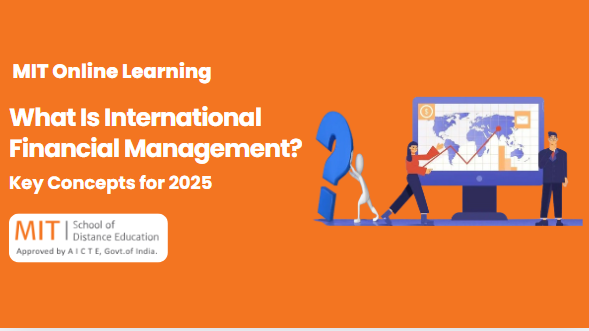
In an increasingly interconnected global economy, the role of International Financial Management has become more critical than ever. As companies expand their operations across borders, finance professionals must understand the complexities of managing money, investments, and risks in multiple currencies and regulatory environments. With 2025 on the horizon, financial leaders must stay updated with the latest tools, strategies, and frameworks to manage international financial operations and ensure sustainable growth effectively.
This blog explores the evolving landscape of international financial management, the key concepts professionals must grasp, and how academic institutions like MITSDE can help prepare future financial leaders.
Understanding International Financial Management
International Financial Management (IFM) refers to the process of making financial decisions for multinational companies operating in different countries. Unlike domestic finance, IFM faces additional challenges, including foreign exchange risk, cross-border taxation, differing accounting standards, and political risks.
Key components of IFM include:
- Managing currency exposure
- Raising and allocating capital globally
- Managing international working capital
- Evaluating foreign investment opportunities
It combines principles from finance, economics, and international business to develop robust strategies for financial planning and decision-making at a global scale.
Why International Financial Management Matters in 2025
Globalization, digital transformation, and geopolitical uncertainties are reshaping the financial landscape. In 2025, businesses need international financial management to:
- Handle currency volatility and protect against economic disruptions
- Ensure FX risk mitigation during global transactions
- Manage international capital structure for optimized debt-equity ratios
- Improve efficiency in global cash flow management
- Align multinational treasury management practices with strategic goals
In short, IFM isn’t just about managing money across borders—it’s about building resilience and agility in a complex economic world.
Key Concepts Every Finance Professional Should Know
1. Foreign Exchange Risk
One of the most significant challenges in international finance is dealing with foreign exchange risk—the potential loss due to currency value fluctuations. For example, if a U.S. company receives payment in euros, a fall in the euro’s value could reduce the dollar-equivalent revenue.
2. Currency Hedging Strategies
To minimize currency risk, companies use currency hedging strategies such as forward contracts, futures, and options. These financial instruments lock in exchange rates, providing greater certainty in cross-border deals and budgeting.
3. FX Risk Mitigation
FX risk mitigation goes beyond hedging—it involves operational strategies like diversifying revenue streams, choosing appropriate invoice currencies, and natural hedging through matching receivables and payables in the same currency.
4. Global Cash Flow Management
Efficient global cash flow management ensures that cash is available where and when it is needed across different markets. It involves consolidating and forecasting cash positions, optimizing intercompany fund transfers, and complying with country-specific liquidity regulations.
5. Cross-Border Financial Operations
From procurement to payments, cross-border financial operations involve additional legal, tax, and compliance considerations. Firms must understand local banking systems, repatriation rules, and transfer pricing to avoid regulatory issues.
6. Managing Exchange Rate Exposure
Managing exchange rate exposure is crucial for long-term planning. This includes transaction exposure (due to receivables/payables), translation exposure (for financial reporting), and economic exposure (impact on market value). Each requires different strategies for control and minimization.
7. Multinational Treasury Management
Multinational treasury management centralizes the control of international cash and liquidity. It allows firms to streamline payments, reduce banking fees, and gain better visibility into global funds.
8. Currency Netting Techniques
Currency netting techniques reduce transaction costs by offsetting receivables and payables in different currencies between subsidiaries. It minimizes the number of transactions and improves working capital efficiency.
9. International Capital Structure
A firm’s international capital structure—how it balances debt and equity across global operations—can impact tax liabilities, financial flexibility, and shareholder value. Choosing between local and global financing sources is a strategic decision in IFM.
Real-World Example: Apple Inc.
To understand how top corporations apply international financial management, consider Apple Inc. The company:
- Generates a significant portion of revenue overseas
- Holds cash in different countries
- Uses currency hedging strategies to stabilize income
- Optimizes its capital structure using global debt markets
Apple’s financial management model serves as a case study in how efficient IFM leads to business stability and growth, especially during economic fluctuations.
Challenges in 2025
As we move into 2025, companies must also contend with:
- Central bank policy shifts in response to inflation and global trade tensions
- Increased emphasis on ESG (Environmental, Social, Governance) in global finance
- Rising cybersecurity threats to cross-border financial data
- Need for real-time financial analytics and automation tools
These developments call for professionals who not only understand finance but also embrace digital transformation and risk intelligence.
How MITSDE Equips You for Global Financial Roles
To build a strong foundation in International Financial Management, aspiring finance professionals need a well-rounded academic experience that blends theory with real-world application. This is where MITSDE (MIT School of Distance Education) steps in.

MITSDE offers a variety of industry-relevant programs designed to cater to learners at different career stages:
✅ PGDM in Finance Management
A 2-year program that builds a strong foundation in financial theory, capital markets, investment analysis, and international finance. It includes in-depth modules on foreign exchange risk, global cash flow management, and international capital structures.
✅ PGDM Executive in Finance Management
Tailored for working professionals, this program offers flexibility without compromising on quality. It covers advanced topics like FX risk mitigation, multinational treasury management, and currency netting techniques to prepare mid-level managers for strategic roles.
✅ PGDBA in Finance Management
This diploma-level program blends business administration with financial specialization. It’s ideal for learners aiming for roles in cross-border financial operations and international banking.
✅ Professional Certification in Finance Management
A short-term certification for skill upgradation, focused on areas such as currency hedging strategies and exchange rate exposure management, relevant for consultants, analysts, and corporate finance professionals.
Why Choose MITSDE for Distance Finance Education?
MITSDE is a trusted name in distance and online management education, offering:
- AICTE-approved programs
- Industry-curated curriculum
- Access to finance simulation tools
- Live webinars, case studies, and placement support
- 24/7 access to e-learning resources
Whether you’re a recent graduate or a working executive, MITSDE’s finance programs are built to fit your schedule and boost your career.
Final Thoughts
International Financial Management is no longer a specialized function limited to MNCs—it’s a core competency for every finance professional in 2025. Mastery over concepts like foreign exchange risk, FX risk mitigation, and multinational treasury management will set you apart in the competitive global market.
To stay ahead, you need not just knowledge but the right platform to learn, apply, and evolve. That platform is MITSDE.
📢 Ready to Lead Global Finance?
🌐 Visit www.mitsde.com to explore programs and start your journey in global finance today!



